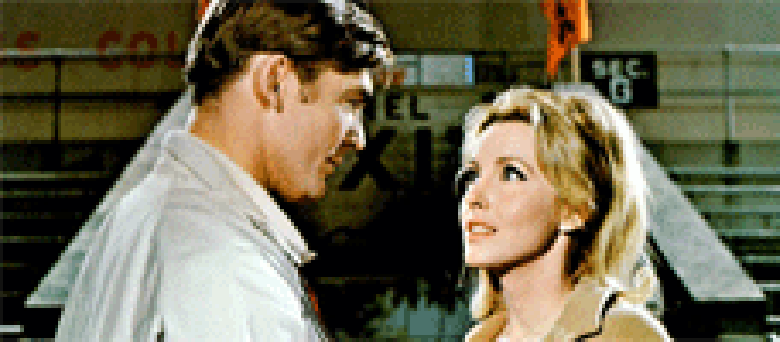Reviews
Howard Hawks
USA, 1965
Credits
Review by Glenn Heath Jr.
Posted on 06 October 2010
Source Paramount DVD
Howard Hawks strategically positions men and women as flipsides of the same professional coin, necessary opposites that invariably push extreme mechanisms of work forward. In Red Line 7000, his late career mash-up of race car thrills and melodramatic spills, Hawks shows there are consistently casualties within this dynamic. Some are physical and others emotional, but each gets an extravagant presentation. As a prolonged montage of car crashes, conversations, and break-ups, Red Line 7000 moves to a different beat than most Hollywood films, taking in the sudden shifts of tone by lingering on moments between climaxes of all kinds. In that sense, it’s the quintessential anti-action film.
But Hawks begins Red Line 7000 with a burst of visceral energy, a kinetic opening credit sequence fetishizing the iconic images of the speedway, whether it’s close-ups of tires squealing or sudden freeze frames of cars skidding out of control. The action is completely mechanical and effective, a relentless snapshot of a dangerous environment just as methodical and inhuman as the savage savannah of Hawks’ prior film Hatari. From here, the locale always remains in the background, even during the supposed tense race sequences later in the film. But the looming danger has been established, and Hawks begins to use vehicles for maneuvering one character into the arms of another.
The art of conversation has always been essential to Hawks, and Red Line 7000 is no different. Verbal interactions allow characters to size each other up, both from a physical and psychological perspective. When stud driver Mike Marsh, played by cold-as-ice James Caan, calmly welcomes back adversary Jim Loomis after a tour on the California circuit, the men talk shop in a short and sweet current of banter. That is until the topic of Holly, a potential fiancé, comes up and Jim’s overzealous eyes create a worrisome streak in his single friend. Women it seems are the enemy. After Loomis dies in a fiery car crash moments later, Holly arrives hoping to find a husband, but instead receives a series of shocking condolences. This isn’t the first love interest of Holly’s to die suddenly, and Hawks treats the female paranoia as a reckless annoyance to her male counterparts. However, something behind this curse sticks, and Hawks spends the better part of Red Line 7000 matching various couples as a litmus test for tragedy or happiness.
Holly becomes engrained in the local speedway routine, joining forces with another widow who owns the local bar where all of the drivers hang out. During an early conversation, Holly muses that they “fell in love with the wrong profession,” once again calling attention to the unsettling current of worry feeding each relationship. Following suit, more drivers enter the fray with or without women in tow. Ned Arp, a poor farmer and young upstart, convinces Mike’s boss Sal that he’s got the chops to drive alongside the superstar. In his introductory scene, Ned meets Sal’s kid sister Julie, who enters frame riding a motorcycle, according to Ned, with the convincing precision of a man. “Don’t you think a girl can ride one of these things?” Julie questions, exasperating Ned’s gender confusion. Needless to say, the sexual tension begins a long line of ups and downs for the young couple.
Later on, Hawks introduces Dan, a handsome giant of a driver over from Europe, his only carry-on luggage a French doll named Gabby. Their insertion into the mosaic complicates matters even more, sending both Holly and Mike into respective fits of smitten uncertainty. This mirroring set of trifecta couples proceed to lap each other verbally and physically, the courtships occasionally interrupted by anti-climactic racing scenes that only prolong the romantic suffering. Still, there’s never any real danger in these couplings, just needy people trying to tame each other into submission. When Mike gets obscenely jealous over Gabby’s past relationship with Dan and throws a lit cigarette at her head, the deed is reconciled as a childish reaction to adult situations, not anything lasting or malicious. Hawks isn’t interested in revenge, or spite, but loyalty, and this becomes the true test of each character’s melodrama.
Just like the professionals driving those high-speed race cars, Hawks’ characters aren’t defined by actions, but timing. The interactions becomes the mechanism, and Hawks finalizes his gender thesis with the women lined up in a perfectly framed three-shot watching as their respective men race each other off-screen. “What a way to make a living” says Holly, in a final expression of angst before all three timidly rise during one last explosive crash. This is a tumultuous life of patterns, routines, check-ups, and maintenances, and I’m not talking about the cars. But Hawks enjoys spending long amounts of time dissecting these character’s neuroses, hanging out with them through good and bad. His uneven but fascinating film languishes in this constant battle between emotional and physical discomfort. Ultimately, his characters, like the audience, get used to living on the edge. But it’s an endless, exhausting race to a invisible finish line.
We don’t do comments anymore, but you may contact us here or find us on Twitter or Facebook.



